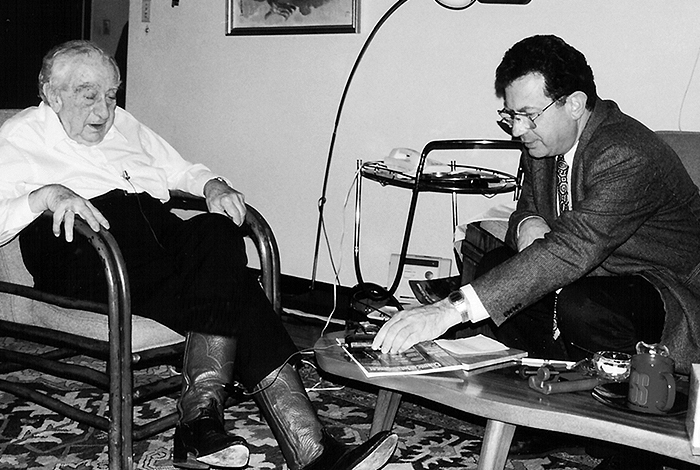 Istvan Hargittai, right, talks with Edward Teller at Stanford in 1996. Courtesy/LANL
Istvan Hargittai, right, talks with Edward Teller at Stanford in 1996. Courtesy/LANL
LANL News:
- June 12 at Bradbury Science Museum
The differences and similarities between Manhattan Project-era scientists at Los Alamos National Laboratory and scientists working at the former Soviet Union’s secret Arzamas-16 installation will be discussed by Professor Istvan Hargittai at 5:30 p.m., June 12 at the Laboratory’s Bradbury Science Museum. The talk is part of the Laboratory’s 70th anniversary lecture series.
According to Hargittai, Los Alamos’ first director, Julius Robert (J. Robert) Oppenheimer and Arzamas-16 leader Yulii B. Khariton had the same first names, were born the same year and were of similar Jewish backgrounds. Oppenheimer led the Los Alamos effort to build the first atomic bomb, while Khariton directed the Soviet effort for nearly a half-century. The similarities even extended to how Arzamas-16 was informally referred to as “Los Arzamas.”
“The first group of stellar physicists at Los Alamos had many similarities to the group of stellar physicists at Arzamas-16, but the differences separated them a world apart,” said Hargittai, professor of chemistry and professor emeritus at the Budapest University of Technology and Economics.
He is editor-in-chief of Structural Chemistry and has master’s and doctoral degrees from Moscow University as well from Eotvos Lorand University in Budapest, Hungary. He holds numerous foreign professional and association memberships. Among them, Hargittai is a member of the Hungarian Academy of Sciences, the Academia Europa (London), the Norwegian Academy of Science and Letters, and the New York Academy of Sciences. He has been a visiting professor of chemistry or physics at the University of Texas, Austin, University of Hawaii, University of Connecticut, and distinguished visiting professor chemistry at the University of North Carolina-Wilmington.
His newest book to be published this summer, “Buried Glory,” is about Soviet scientists who made the Soviet Union a superpower. He also wrote “The Martians of Science,” “Judging Edward Teller” and “Drive and Curiosity.”
About the 70th anniversary lecture series (http://www.lanl.gov/museum/events/70th-events.shtml )
Los Alamos National Laboratory celebrates 70 years of service to the nation in 2013. This free lecture series is part of a number of activities planed to mark the anniversary.
All events at the Bradbury Science Museum are free and open to the public. Bradbury Science Museum is located at 1350 Central Ave., in downtown Los Alamos. Museum hours are 10 a.m. to 5 p.m., Tuesday through Saturday and 1 to 5 p.m., Sunday and Monday.

